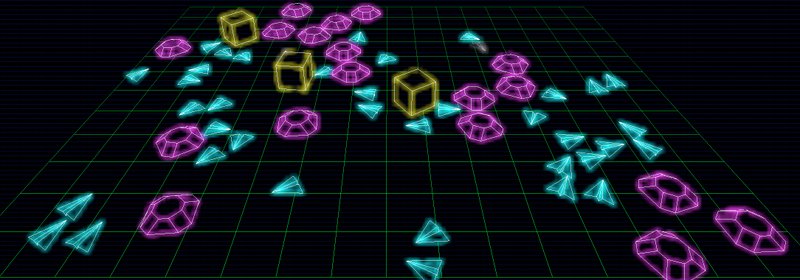Flocking Boids
![]() Hi … I got a bit stuck with my 3D space game when trying to get real-time impostors right. Impostors are dynamic billboards for rendering hundreds of distant asteroids. After a three week holiday, it was hard getting back into the code, so I put it on hold for now. On the bright side, I started working on a new arcade game that is really 2D, but with a 3D twist. It is inspired by Geometry Wars / |g|ridwars, GridRunner, and another old Jeff Minter game that features four cannons along the screen edges.
Hi … I got a bit stuck with my 3D space game when trying to get real-time impostors right. Impostors are dynamic billboards for rendering hundreds of distant asteroids. After a three week holiday, it was hard getting back into the code, so I put it on hold for now. On the bright side, I started working on a new arcade game that is really 2D, but with a 3D twist. It is inspired by Geometry Wars / |g|ridwars, GridRunner, and another old Jeff Minter game that features four cannons along the screen edges.
An intern that I’m currently working with, pointed out flocking to me. The guy is studying game technolology—you can actually get a master’s degree in game technology nowadays, how great is that?
Anyway, flocking, also known as swarming, is a technique reminiscent of particle systems. While particle systems simulate physics models like fireworks, smoke, or fountains (water drops), flocking is an AI system that is great for simulating groups of animals. An impressive YouTube video shows such a simulation of a flock of birds that is under attack by two birds of prey.
On first thought, you might think that group behaviour is programmatically implemented by controlling the group as a whole. This is not true. Every bird (or boid, as the bots are called) in the flock is an autonomous entity sporting its own artificial intelligence.
How is this implemented? Each boid has an area of sight. If it sees it is going to collide with another boid (or object), it will adjust its heading to avoid collision.
At the same time, the boid wants to stay with the group. It does this by adjusting its heading, to get close to others, while trying to match the heading of a boid that is near. As a consequence, the boid will follow others.
Coming from an age when computers were slow, I first thought that this would be too slow to do in real-time. As it turns out, a modern cpu has no problems whatsoever with the little bit of math required for directing each boid. A pitfall is to have a boid influence another, and recursing because this action influences another, and … You should not try to solve a mathematical puzzle here. Instead, focus on only one boid at a time and have it make the decision of how to adjust its heading. Do this for every boid, every discrete time step.
I implemented the AI rules in 2D in a game, and while the result is not as impressive as the flock of birds video, it is kind of cool. I started out by making sure that the monsters (or boids) would no longer pass through each other. This is done with a simple circle collision test. When a monster collides, it chooses another direction to move in. Once this was working, changing the code to get flocking behaviour was rather easy: increase the collision radius (area of sight) and adjust the direction only slightly rather than choosing an entirely different direction.
One problem I ran into was that the play area in this game is small and I don’t want monsters to fly off the screen. So, the monster had to turn at the edges. Again, increase the area of sight, and have it adjust the direction.
In the game, the gliders (paper airplane models) flock together, while the magenta thargoids are going around like bumper cars, and are disturbing the gliders. The yellow cubes are stationary obstacles in the arena.
Note that it is possible to extend the AI with more rules, but flocking is a technique that already yields quite amazing results with just a few simple rules.
